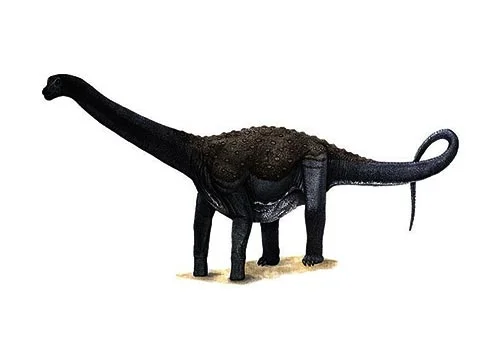Maxakalisaurus (Maxakali lizard, after a Topa divinity)

Max-ah-kal-e-sore-us
A. W. A. Kellner, D. A. Campos, S. A. K. Azevedo, M. N. F. Trotta, D. D. R. Henriques, M. M. T. Craik & H. P. Silva - 2006
Herbivore
Estimated 13 meters long
Sauropod
M. topai (type)
Brazil - Adamantina Formation
Late Cretaceous, 80 million years ago
Maxakalisaurus Facts
Maxakalisaurus is a genus of titanosaurian sauropod dinosaur that lived in what is now Brazil during the Late Cretaceous period, approximately 80 million years ago. It was named after the Maxakali indigenous people of Brazil and their god, Topa, and its name means “Maxakali lizard.”
The holotype of Maxakalisaurus was discovered in the late 1990s in the Brazilian state of Minas Gerais, and it consists of a nearly complete skeleton that is missing only the skull and the front part of the neck. The skeleton is estimated to be around 13 meters (43 feet) long and may have weighed up to 9 tons. The discovery of this specimen was significant because it is one of the most complete titanosaurian sauropod skeletons ever found in South America.
Maxakalisaurus is believed to have been a herbivorous dinosaur that fed on vegetation such as ferns, cycads, and conifers. Like other sauropods, it had a long neck and a small head with teeth adapted for stripping vegetation. Its long tail and massive limbs would have allowed it to support its weight and move around efficiently, although it likely moved relatively slowly.
One interesting aspect of Maxakalisaurus is its vertebrae, which have unique features that suggest it was adapted for life in a particular habitat. Its vertebrae are very wide and flat, which may have allowed it to support its weight and move around in marshy or swampy areas. This is supported by the fact that the sediments in which the fossils were found are believed to have been deposited in a wetland environment.
Overall, Maxakalisaurus is an important dinosaur for understanding the evolution and diversity of sauropod dinosaurs, particularly those that lived in South America during the Late Cretaceous period. Its discovery and study have provided important insights into the anatomy, behavior, and habitat of these fascinating creatures.



